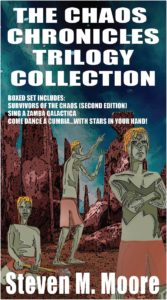Review of Karpf’s Prelude to Extinction…
Prelude to Extinction. Andreas Karpf, author. I hope Dr. Karpf reads this review because, as one physicist to another (ex-physicist in my case), I say to him, “You, sir, have written one helluva good hard sci-fi novel!” With a low price no Big Five conglomerate’s publisher would even consider, I suppose it’s self-published—Howey’s Wool and Weir’s The Martian were too (initially), and this one deserves more fame.
My summary here could make it sound like space opera, but it’s a solid albeit risky extrapolation of current science like all the best hard sci-fi novels that now are so hard-to-find in this current publishing universe. In fact, the technological razzle-dazzle even leaves Star Trek and Star Wars far behind as the reader interacts with the verbal imagery. And this novel is also far better than any computer game because there actually is a plot!
So here’s my summary: Captain Jack leads humans’ first expedition to a nearby star system (for some reason, not the nearest—there are stars like the sun that are much nearer). They find a destroyed ET colony—intelligent beings were already there eons ago, terraforming the planet. And when I say destroyed, I mean destroyed! The bad ETs even left deadly traps for anyone else who might arrive. The humans have to flee and are chased from one star system to another, using the murdered colonists’ (the good ETs’) stargates, until they finally meet the good guys. They’re so advanced they have lost the ability to fight those bad ETs bent on destroying all other intelligent beings in that part of the galaxy. Unlike the Rangers and Tali in the second novel of my “Chaos Chronicles Trilogy,” the author doesn’t provide names for the good or bad ETs, but the humans show the good guys how to fight the bad.
This summary doesn’t do justice to the novel or even the technological razzle-dazzle. The author gets carried away with the description of the flora and fauna on that first planet (reminding me a bit of Weir’s ugly, verbose potato-growing description in The Martian); this first part drags a bit. But readers should stick with the story because the plot accelerates. The author paints a nice contrast between the Earth crew and those complacent good ETs who are a million years more advance than humans. The crew has its typical organizational and command problems—as I read, I sometimes expected a mutiny by those in the crew as ready to run away from a fight as the good ETs.
The stargates are fun—huge devices (compared to starships) that create something like wormholes. They’re used to fold space-time and go from star system to star system in much shorter subjective time than a starship (of course, starships are needed to construct them and put them into orbit around target planets—you have to wonder why the good ETs haven’t invented something like von Neumann stargates that reproduce themselves around the cosmos). Both the stargates and the good ETs’s stardrives are examples of what a few million years of scientific progress can bring, while the bad ETs’ stardrives (they fear the stargates) are inferior. The bad ETs are evil thugs and not too bright in comparison to the good guys—we never actually meet the bad ones, only their soldiers, and they appear to be nomad marauders bent on murdering all the competition.
This is the best sci-fi I’ve read in a long time, much better than Wool or The Martian, and reaffirms my belief that non-scientists are a bit crippled when it comes to writing good, hard sci-fi (hard to be a touch typist with one arm tied behind your back?). The extrapolations of current science that are necessary are handled well in this novel and rarely well by non-scientists, including by those screenwriters for Star Trek and Star Wars. (Of course, I regret some of my own extrapolations. The difficulty is that the farther out in time the extrapolation, the more it appears like magic. Extrapolations aren’t that easy!)
By the way, the title and epilogue suggest that there will be a series. I hope so. I’ll look forward to it!
***

Comments are always welcome!
The Chaos Chronicles Trilogy Collection. Survivors of the Chaos takes the reader from a dystopian Earth dominated by mega-corporations and controlled by their mercenaries, to the 82 Eridani star system. Sing a Zamba Galactica starts with first contact with friendly ETs and the invasion of Earth by unfriendly ones, and ends with Humans saving that collective intelligence known as Swarm. In Come Dance a Cumbia…with Stars in Your Hand!, Humans and ETs combat a psycho-industrialist who dreams of being the absolute ruler of Near Earth space. Exciting sci-fi that’s bundled in a three-novel package for your enjoyment. Available on Amazon and Smashwords and all the latter’s affiliated retailers (iBooks, B&N, Kobo, etc.) and lending and library services (Scribd, Overdrive, Baker & Thomas, Gardners, etc.).
Around the world and to the stars! In libris libertas!
